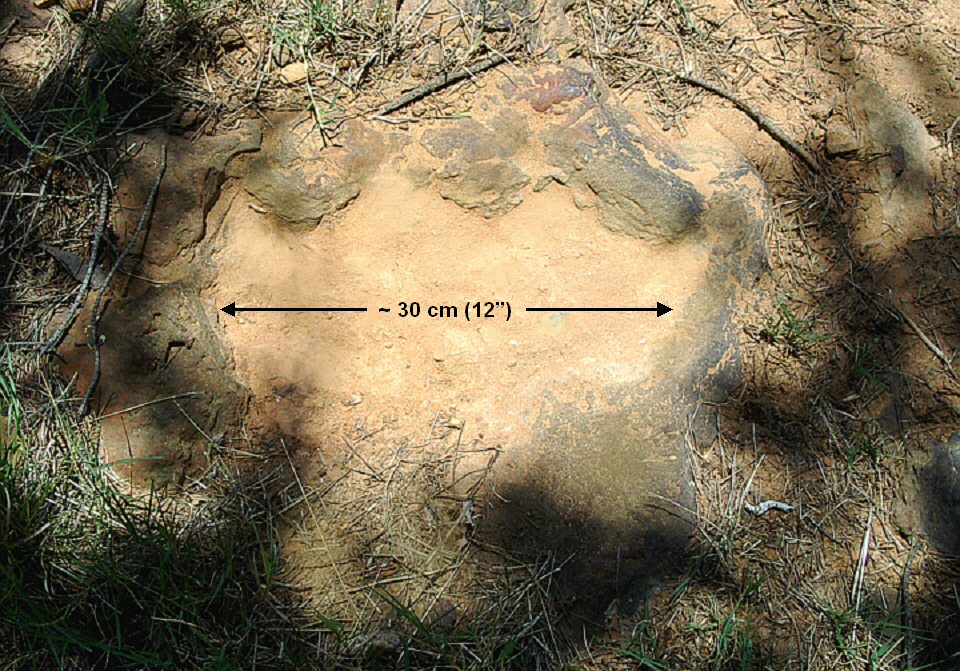A grouping of 110 to 112 million-year-old dinosaur footprints pressed into mud from the Cretaceous Period have now been safely moved from their original setting on the grounds of NASA’s Goddard Space Flight Center in Greenbelt, Md. Until further scientific study is possible, the footprints, now wrapped in protective material, will be stored on the Goddard campus.
The discovery of dinosaur footprints came to light in August 2012 when well-known Maryland-based dinosaur hunter Ray Stanford brought one track to the center and the public’s attention. Later analysis by emeritus paleontologist Rob Weems, of the U.S. Geological Survey in Reston, Va. and Goddard’s consultant paleontologist Lee Monnens verified the track and discovered additional footprints hiding under a thin layer of topsoil in the same rock layer.
Earlier this year, the footprint-bearing rock was reinforced and removed.
“We successfully made a mold of the upper surface to preserve the dinosaur footprints,” said Stephen Godfrey, Curator of Paleontology at the Calvert Marine Museum (www.Skullptures.com). He was contracted by Goddard to preserve and move the preserved footprints for further scientific examination and eventual display.
The original footprint was almost certainly that of a nodosaur, Godfrey confirmed.
“This is an armored type of dinosaur that had spikes all over their body. The spikes consist of bones that were embedded in their skin,” he said. “With the second large print, the orientation was different, and the shape of the print is different as well.”
Godfrey suspects the second creature was a three-toed ornithopod, perhaps from the iguanodontid family of dinosaurs, which were also herbivores much like the nodosaur.
A third, smaller footprint was originally found superimposed over the nodosaur track. Experts say it is likely a juvenile nodosaur meandering behind its parent on a more circuitous route.
After the dinosaurs left the footprints, single-celled organisms feeding on nutrients in the Cretaceous mud precipitated an iron-rich mineral known as hematite that solidified and preserved the tracks until natural processes buried and fossilized them, said Stanford.
Excavation of the stone with the dinosaur footprints had to wait until geologists and paleontologists learned more about the find and its surroundings, in accordance with Bureau of Land Management guidelines.
In December, 2012, Goddard scientists using ground penetrating radar showed that the sedimentary rock layer bearing these prints was preserved in its original location, but that investigation found no additional indications of locations of dinosaur track specimens of scientific value.
Further hands-on exploration by Goddard volunteers, including Godfrey, took place in mid-December 2012. Volunteers dug in several areas around the initial find location, but turned up no additional preserved footprints.
The entire find, containing at least three dinosaur footprints, is approximately seven feet long and three feet across at its widest point. Additionally, the footprint-bearing layer is bonded to a separate layer of iron-rich sandstone that complicated the efforts to extract and preserve it.
Before removing the rock layer, Godfrey made a silicon-rubber cast of the prints, then jacketed the entire find in multiple layers of plaster-soaked burlap (i.e. just like a cast) to add rigidity and to further ward against breakage during transport. Galvanized steel pipes wrapped into the jacket acted like splints to provide additional structural support.
The combined weight of the footprint, field jacket material and surrounding soil that was removed was estimated at approximately 3,000 pounds, so extra care was taken in moving it to avoid damaging the rather extraordinary find.

The future disposition of the dinosaur-track-bearing rock layer has not yet been determined. Senior management at Goddard will work with government officials and scientists to determine the best course of action.
“One of the amazing aspects of this find is that some of the starlight now seen in the night sky by astronomers was created in far-distant galaxies when these dinosaurs were walking on mud flats in Cretaceous Maryland where Goddard is now located,” said Jim Garvin, Chief Scientist at NASA Goddard. “That starlight (from within the Virgo Supercluster) is only now reaching Earth after having traveled through deep space for 100 million years.”
Center Director Chris Scolese added, “Much of the work at Goddard is focused on Earth and space science. The discovery and follow-on work with the dinosaur footprints created a wonderful blending of sciences. You have astronomy – the study of the Universe, geology – the study of the Earth, and paleontology – the study of the prehistoric life on Earth and they have all come together here at NASA Goddard.”
Read more on the history of Goddard’s nodosaur:
http://go.nasa.gov/PMe8rJ


























